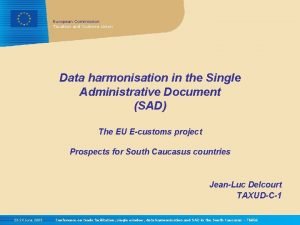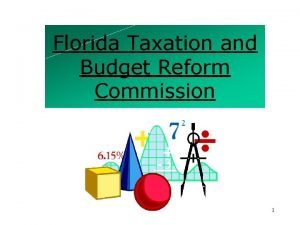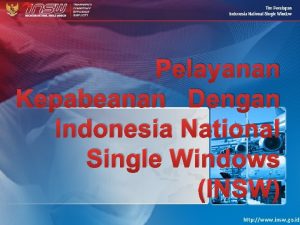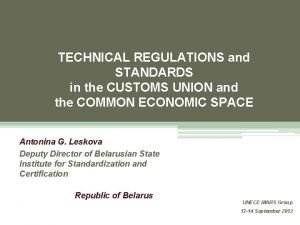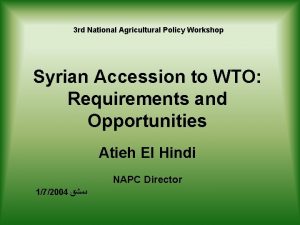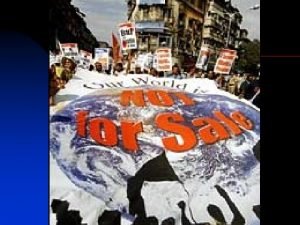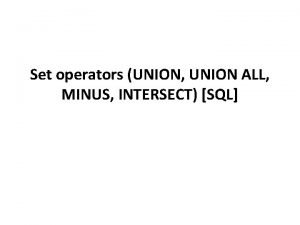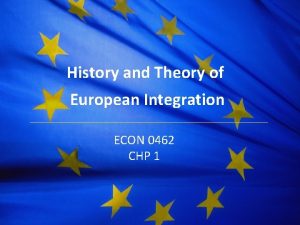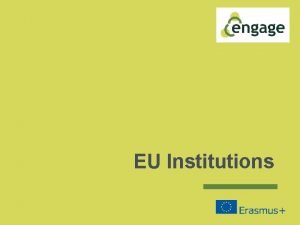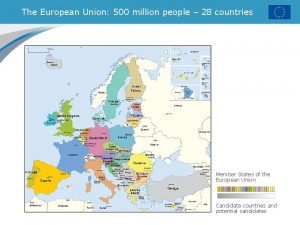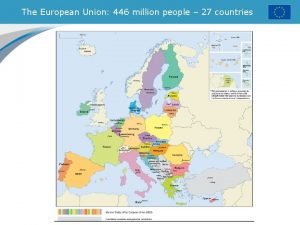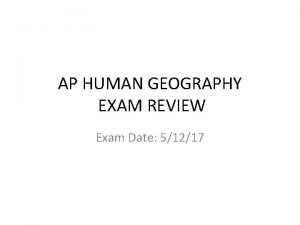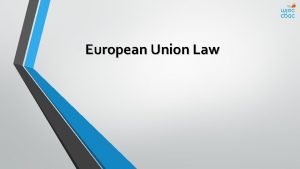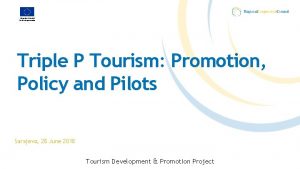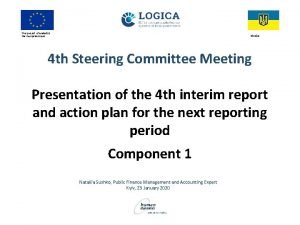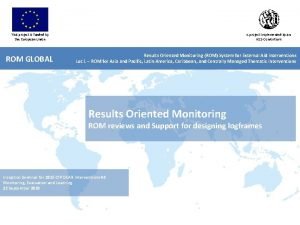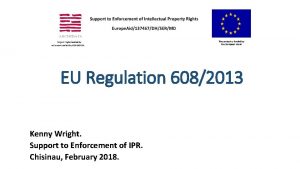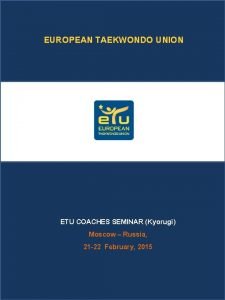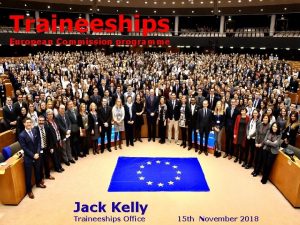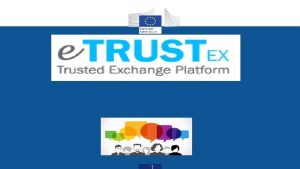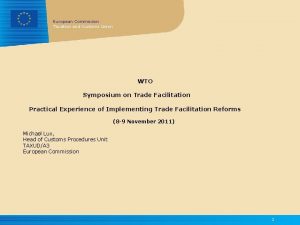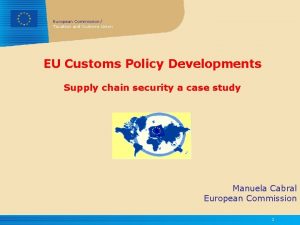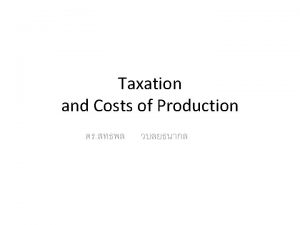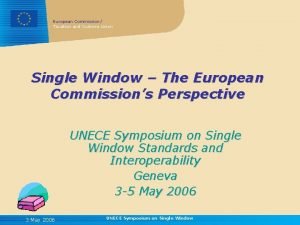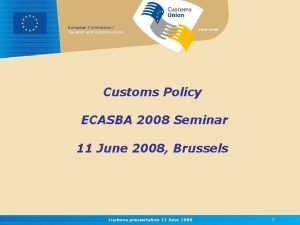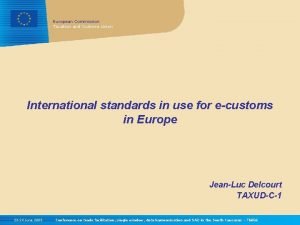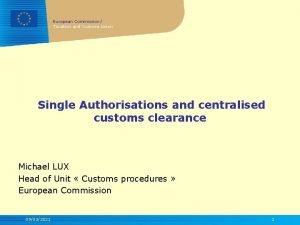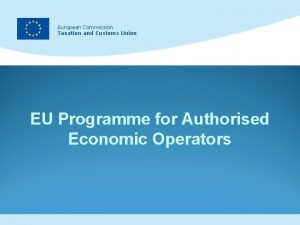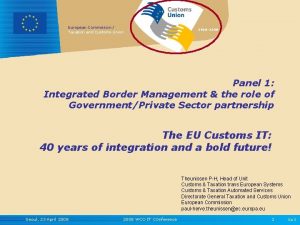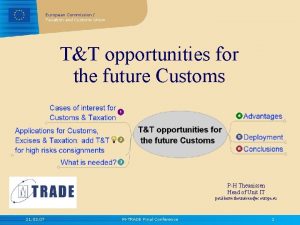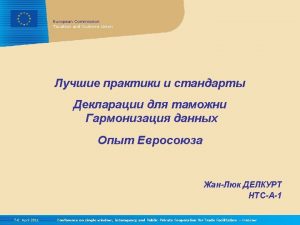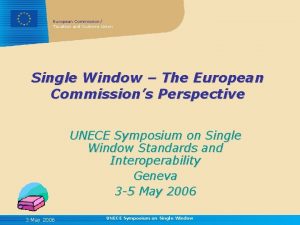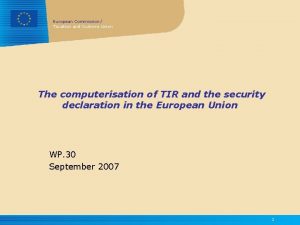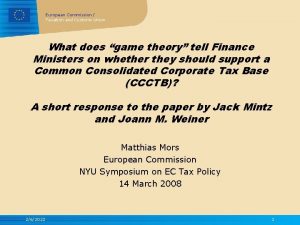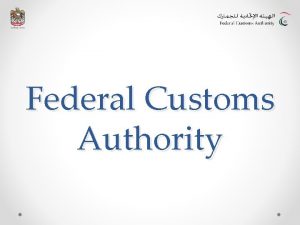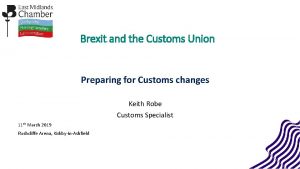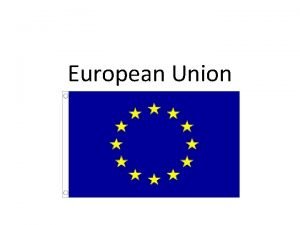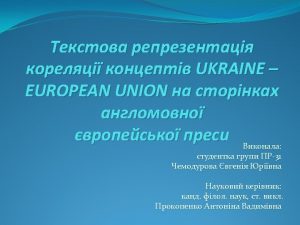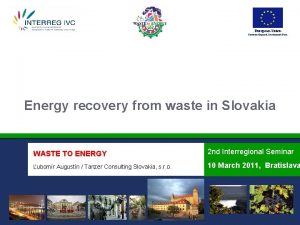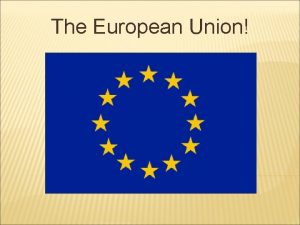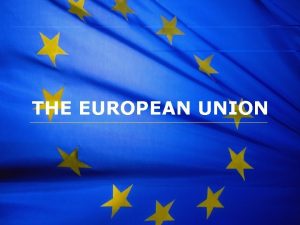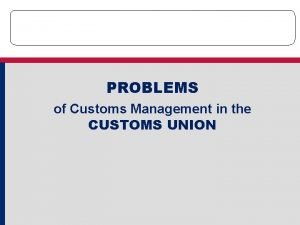European Commission Taxation and Customs Union WTO Symposium





























- Slides: 29

European Commission Taxation and Customs Union WTO Symposium on Trade Facilitation Practical Experience of Implementing Trade Facilitation Reforms (8 -9 November 2011) Michael Lux, Head of Customs Procedures Unit TAXUD/A 3 European Commission 1

European Commission / Taxation and Customs Union BEST PRACTICES IN THE EU Based on The Convention on a Common Transit Procedure 2

European Commission / Taxation and Customs Union Some data Geographical scope: - 30 countries (EU 27) Volume: - Approx. 12+ million movements per year* - Approx. 33+ thousand of movements in NCTS per business day* * Community transit + common transit 3

European Commission / Taxation and Customs Union Crossing borders in transit- Best Practices 4

European Commission / Taxation and Customs Union A main characteristic of the common transit procedure One single procedure from start to finish Start End Compare to the TIR Convention based on a series of standardized national transit procedures Start End 5

European Commission / Taxation and Customs Union How does the procedure operate ? Let us take a closer look at: • New Computerised Transit Procedure (NCTS) • Guarantees • Enquiry procedure and recovery • Simplifications 6

European Commission / Taxation and Customs Union A single Customs Union but national fiscal territories required internal facilitation : Community transit procedure MS 1 MS 2 MS 3 MS 4 MS 5 MS 6 MS 7 MS 8 MS 9 MS 10 MS 11 MS 12 EU goods (free circulation) : Non-EU goods: 7

European Commission / Taxation and Customs Union Extension of Community transit to neighbouring countries: common transit procedure (starting 1972) IS MS 1 MS 2 MS 3 Third country NO MS 5 CH (+ LI) MS 6 Third country MS 6 MS 7 MS 8 Third country EU goods (free circulation) : Non-EU goods: 8

European Commission / Taxation and Customs Union EU Internal Market (1993) IS MS 1 MS 2 MS 3 Third country NO MS 5 CH (+ LI) MS 6 Third country MS 6 MS 7 MS 8 Third country EU goods (free circulation) : Non-EU goods: 9

European Commission / Taxation and Customs Union Geographical scope today Convention on a common transit procedure / SAD Convention applies between the EU, Iceland, Norway, Switzerland, Liechtenstein Community transit applies in the customs territory of the EU (27 MS) + Andorra & San Marino (Customs Unions) Note: in the territory of the EU the common transit convention follows the rules of Community transit 10

European Commission / Taxation and Customs Union Goals - Facilitation of border crossing Trade facilitation Cost saving Efficient controls Balance between the economic interest of operators and the interest of customs (simplified procedures, modulation of guarantee, authorised consignor/consignee, etc. ) - Alignment of legislation, formalities and procedures - Safety/Security declaration can be combined with transit 11

European Commission / Taxation and Customs Union Accession to the Conventions - A country must be invited by the EC/EFTA Joint Committee - Formal accession procedure is described in Articles 15. 5 and 15 a of the Common Transit Convention (Articles 11. 5 and 11 a of the SAD Convention) - Communication (COM(2001)289 of 31. 5. 2001) sets out the general conditions that must be met by the EU pre-accession countries - Communication (COM(2010)668 of 18. 11. 2010) sets out a strategy to prepare certain neighbouring countries for accession to the Conventions and re-confirms the conditions for accession - Council support received (28. 03. 2011, 6800/2/11) conclusions on a strategy to prepare certain neighbouring countries for accession 12

European Commission / Taxation and Customs Union General conditions for accession • Ability to implement the whole acquis: - adopt the legal provisions; have the operational administrative structure in place; a computerised transit system (NCTS); connection to the CCN/CSI network linking all Contracting Parties (separate Convention), alternative ways of connection are under consideration (SPEED 2) 13

European Commission / Taxation and Customs Union Future accessions • Croatia and Turkey are first in line to accede to the Conventions • Formal process may start after positive evaluation missions and presentation of missions reports (November-December 2011) • Council Decisions on the EU position concerning an invitation to Croatia and Turkey to accede to the conventions required (already prepared, to be discussed after the evaluation missions) • Decision of the EC-EFTA Joint Committee (February 2012) • Deposit of the accession instruments (April 2012) • Extension of the Conventions (July 2012) 14

European Commission / Taxation and Customs Union NCTS Principles and Benefits • For Customs: ü ‘Real time’ exchange of information (declaration, advance arrival information, guarantee check, etc. ) ü Customs authorities are linked electronically ü More effective customs control (risk analysis, guarantee, discharge) ü Statistics ü Safety/security data combined with transit 15

European Commission / Taxation and Customs Union NCTS Principles and Benefits -2 • For business: ü Fast administrative process ü Faster release of guarantee ü More information available (e. g. movement status info) ü Faster discharge (less open movements and enquiries) ü Safety/security data combined with transit 16

European Commission / Taxation and Customs Union NCTS architecture NCTSsystem System Architecture International domain 27 EU Member • States AND SM National domain External domain NO IS CH & LI Common Communications Network and Interface (CCN/CSI) Customs offices Traders 17

European Commission / Taxation and Customs Union Guarantee Individual guarantee: - Covers a single operation - By cash deposit, by guarantor or by voucher (€ 7000) - Covers the full amount of potential customs debt Comprehensive guarantee (simplification): - Covers several operations - Calculated as the potential debt of one week’s operations (reference amount) - Guarantee level 100% of potential debt or reduced to 50% or 30% or guarantee waiver (depending on meeting specific criteria) - Guarantee furnished by guarantor (third party established in a Contracting Party) 18

European Commission / Taxation and Customs Union Enquiry procedure • Objective is to determine how the debt incurred, identify the debtor(s) and determine the authorities for recovering the debt • Fast electronic procedure based on exchange of messages via NCTS • Starts at the latest one week after the goods should have been presented at the office of destination • Recovery of customs debt starts seven months from the date the goods should have been presented at destination (shorter period in case the operator provides no or insufficient information) 19

European Commission / Taxation and Customs Union Recovery procedure • Customs debt covers import and export duties and other charges • There can be more than one debtor (joint and several liability) • If there is a guarantor he is liable for the debt incurred by the principal (holder of the procedure) • Customs debt must be notified to guarantor within specific timelimits in order to maintain his liability • Recovery is carried out in accordance with the country’s own regulations 20

European Commission / Taxation and Customs Union Customs may authorise simplifications to operators meeting general and specific conditions - Use of comprehensive guarantee/waiver - Status of authorised consignor/consignee - Use of seals of a special model - Exemption of prescribed itinerary - Simplified transit procedures (rail, air, sea, pipeline) - National/bilateral/multilateral simplifications 21

European Commission / Taxation and Customs Union Example: Authorised consignor/consignee Authorisation stipulates how and when to inform customs / measures of identification / categories of goods Authorised consignor: • Places goods under transit from authorised premises without presentation to customs • Must hold a comprehensive guarantee / guarantee waiver • Electronic communication with supervising customs office Authorised consignee: • Receives goods placed under transit at authorised premises without presentation to customs • Electronic communication with supervising customs office 22

European Commission / Taxation and Customs Union TIR Convention Objectives: • allow the movement of goods between and through different customs territories (68 Contracting Parties) under customs seals under relief from import duties and taxes and without application of economic commercial policy measures • Provide an international system replacing national procedures (including documentations, guarantee) but providing the same guarantees for the national revenue 23

European Commission / Taxation and Customs Union Weakness of the current paper TIR system • Paper format • Formalities for holders at every border crossing • No risk management prior to physical presentation of goods • Movements in the EU monitored on the basis of information exchange on paper • Prolonged time limits for enquiry • Fraud fighting mainly at national level • No automatic guarantee checks • Statistics collected and available only from Contracting Parties 24

European Commission / Taxation and Customs Union Computerization of the TIR procedure • The e. TIR project – Discussed since 1997 by the Contracting Parties to the TIR Convention – Aims to progressively computerise the TIR procedure between all Contracting Parties • NCTS/TIR – Computerization of the TIR procedure within the European Union- as of 1 st January 2009 25

European Commission / Taxation and Customs Union What we want to avoid 26

European Commission / Taxation and Customs Union IDEAL SITUATION Transit should be trouble free 27

European Commission / Taxation and Customs Union Follow EU transit operations on line • Transit map • http: //ec. europa. eu/taxation_customs/dds 2/transit_ emap. jsp? Lang=en 28

European Commission / Taxation and Customs Union Thank you Website: http: //ec. europa. eu/taxation_customs/procedural_aspects/ transit/common_community/index_en. htm - Legislation - Transit Manual - Brochure Name: Michael LUX Telephone: +32 -2 -29 54 257 E-mail: Michael. Lux@ec. europa. eu 29
 European commission taxation
European commission taxation Taxation and budget reform commission
Taxation and budget reform commission Insw pib
Insw pib Customs union technical regulation
Customs union technical regulation Graduated commission jobs
Graduated commission jobs Functions of wto
Functions of wto Functions of the world trade organization
Functions of the world trade organization Nafta and wto
Nafta and wto Sql union minus intersect
Sql union minus intersect European union history
European union history The european institutions
The european institutions Co-funded by the erasmus+ programme of the european union
Co-funded by the erasmus+ programme of the european union Co-funded by the erasmus+ programme of the european union
Co-funded by the erasmus+ programme of the european union European union 28 countries
European union 28 countries European union 28 countries
European union 28 countries European union military
European union military Primate city definition ap human geography
Primate city definition ap human geography Https://europa.eu/european-union/index_en
Https://europa.eu/european-union/index_en This project is funded by the european union
This project is funded by the european union This project is funded by the european union
This project is funded by the european union This project is funded by the european union
This project is funded by the european union This project is funded by the european union
This project is funded by the european union This project is funded by the european union
This project is funded by the european union This project is co-funded by the european union
This project is co-funded by the european union Co-funded by the erasmus+ programme of the european union
Co-funded by the erasmus+ programme of the european union This project is funded by the european union
This project is funded by the european union European taekwondo union
European taekwondo union Eurostars-3
Eurostars-3 Trainee european commission
Trainee european commission Martine deprez european commission
Martine deprez european commission
